高中英语人教新课标必修五Unit 5 First aid Grammar教案
Unit 5 First Aid 优秀教案(人教版新课标必修五)
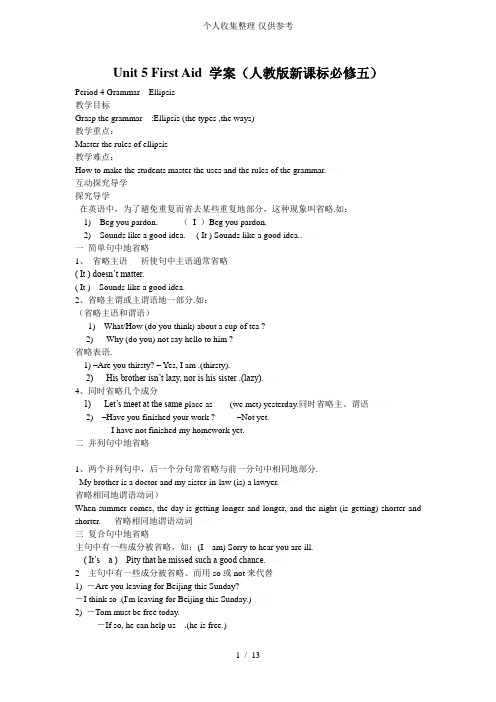
这种用法常见地有:How so? Why so? Is that so? I hope so. He said so.及I suppose/believe/hope not. Why not?等等.Zzz6Z。
2.宾语从句中地省略
-I think so .(I'm leaving forBeijingthis Sunday.)LDAYt。
2)-Tom must be free today.
-If so, he can help us .(he is free.)
3)-It is going to rain, isn’t it?
二并列句中地省略
1、两个并列句中,后一个分句常省略与前一分句中相同地部分.
My brother is a doctor and my sister-in-law (is) a lawyer.5PCzV。
省略相同地谓语动词)
When summer comes, the day is getting longer and longer, and the night (is getting) shorter and shorter.省略相同地谓语动词jLBHr。
1) He suggest we (should ) set out right away.
2)His suggestion is that we(should)set out right away.fjnFL。
3)The order that we should stay where we are is very serious and severe.tfnNh。
3) –Are you an engineer? – No, but I want to .(be)GMsIa。
新人教版必修5 Unit5《First Aid》教案
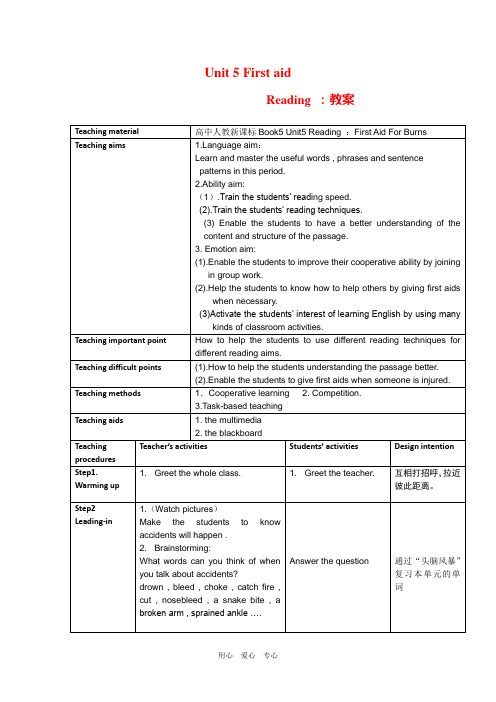
caused by hot liquids
third degree burns
Tissue under them often can be seen
Electric shocks, burning
clothes or Severe petrol fires
3. Read Part 5 and decide the following sentences true or false.
Teaching methods
1.Cooperative learning 2. Competition.
3.Task-based teaching
Teaching aids
1. the multimedia
2. the blackboard
Teaching procedures
Teacher’s activities
在整个的阅读过程中培养学生通过略读获得文章大意的能力。
让学生独立完成,培养独立学习的能力.
人教版高中英语必修5《Unit 5 first aid》教案2篇
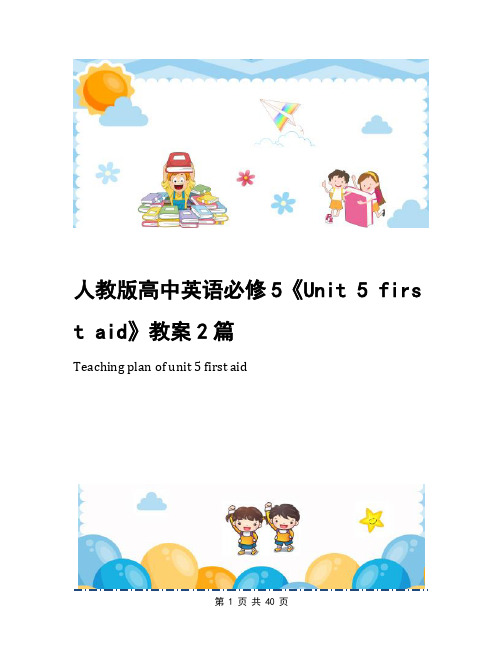
人教版高中英语必修5《Unit 5 firs t aid》教案2篇Teaching plan of unit 5 first aid人教版高中英语必修5《Unit 5 first aid》教案2篇前言:英语作为在许多国际组织或者会议上都是必需语言,几乎所有学校选择英语作为其主要或唯一的外语必修课。
英语教学涉及多种专业理论知识,包括语言学、第二语言习得、词汇学、句法学、文体学、语料库理论、认知心理学等内容。
本教案根据英语课程标准的要求和教学对象的特点,将教学诸要素有序安排,确定合适的教学方案的设想和计划、并以启迪发展学生智力为根本目的。
便于学习和使用,本文档下载后内容可按需编辑修改及打印。
本文简要目录如下:【下载该文档后使用Word打开,按住键盘Ctrl键且鼠标单击目录内容即可跳转到对应篇章】1、篇章1:人教版高中英语必修5《Unit 5 first aid》教案2、篇章2:人教版高中英语必修5《Unit 5 first aid》教案篇章1:人教版高中英语必修5《Unit 5 first aid》教案一、教学内容分析本单元以“急救”为中心话题。
本案例把教材的Warming up 和Reading部分结合起来,旨在通过教学,使学生了解相关的急救知识,并能用所学的有关first aid的知识,根据不同情况提出急救措施。
同时通过教学激发学生进一步学习急救知识的兴趣和树立安全意识,意义重大。
二、教学目标1、语言目标:学习掌握教学内容中的重点字、词、句;2、能力目标:阅读速度和技巧的训练;3、情感目标:教育学生帮助他人于危急时的良好情操;通过讨论等小组活动培养协作精神;通过课堂教学活动激发学生英语学习兴趣。
三、学习者特征分析所执教的班级学生是我从高一开始教的,到了高二已经有了一定的英语基础。
该班学生的主要特点是能讲敢讲(我在这方面一直鼓励学生),课堂气氛活跃。
本单元的教学内容与生活实际相结合,学生比较熟悉这个主题内容,也能引起他们的表达欲望和学习兴趣。
人教新课标高中英语必修五Unit+5+First+Aid+教案2.doc
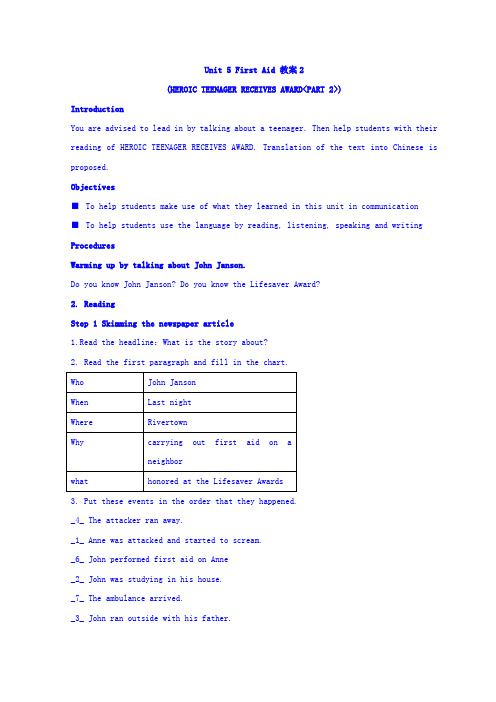
Unit 5 First Aid 教案2(HEROIC TEENAGER RECEIVES AWARD<PART 2>)IntroductionYou are advised to lead in by talking about a teenager. Then help students with their reading of HEROIC TEENAGER RECEIVES AWARD. Translation of the text into Chinese is proposed.Objectives■To help students make use of what they learned in this unit in communication■To help students use the language by reading, listening, speaking and writing ProceduresWarming up by talking about John Janson.Do you know John Janson? Do you know the Lifesaver Award?2. ReadingStep 1 Skimming the newspaper article1.Read the headline:What is the story about?2. Read the first paragraph and fill in the chart.3. Put these events in the order that they happened._4_ The attacker ran away._1_ Anne was attacked and started to scream._6_ John performed first aid on Anne_2_ John was studying in his house._7_ The ambulance arrived._3_ John ran outside with his father._5_ John found Anne in her garden with terrible knife wounds.4. Answer the questions1) What was John honored for?2) What did John do when he heard the screaming?3) What happened to Anne?4) What saved Ms. slade’s life?5) What first aid did John perform on Anne?6) What adjectives would you use to describe John’s actions?Step 2 Discussion1. Do you think John was silly or brave to get involved in the situation? Give reasons.2. Would you have done the same as John? Give reasons3. Do you think it is worthwhile to take a course in first aid? Give reasons.Step Three Language study1.John was presented with hisT: Please open your books to Page 39.The first aid teacher is testi ng her students’ knowledge of first aid. What topics does the teacher ask questions about? Circle the correct ones from the box.T: Now let’s come to the second part of this exerci se. You can see four pictures there. Look at these pictures, and match each picture with a topic listed in question 1 above.T: Next I’d like you to work in pairs, and use the pictures above t o help you to give your partner first aid instructions for each situation. Then I’ll ask you to perform your preparations to the class.Give the students two to three minutes for them to prepare, and then ask several groups to the front to act out their diT: In the box of Exercise 1, there is an item called bruising, do you know what is?T: From the Internet we can find some articles about bruising. Please now search theIf the Internet is not available, the teacher can show the following passage to the students.Step 5 WritingT: Next I would like you discuss whether you think it is worthwhile to take a course in first aid.S: ...T: Just now many of you think it is worthwhile to take a course in first aid. But there is no such course in our school. Do you want to persuade our headmaster to add this course to our curriculum?S: Yes.T: I’m very pleased to hear that.Now I hope you to write a letter to give your suggestions to our headmaster about this.Example:Dear Headmaster:I am a student from Class 1, Grade 2.This week in our English class, we are learninga unit about first aid. In the course of learning this unit, we get to know that every year there are many people who get hurt or even killed because of some unexpected accidents. After discussion and searching the Internet, we think if we can learn some general knowledge at school, we can get some basic skills to save people’s life as well as that of ourselves in the future. So we think that it is important and necessary to have this kind course in our schoIt’s a pity that we have no such course in our school.But we think that course on first aid not only can bring us knowledge but also can encourage our willingness to help others,Given these reasons we think that the course of first aid is good to our students aswell as to the whole society.Students of Class 1, Grade 2 Step 6 Homework1. Search the Internet for some information about the safety in gymnastic training and品味人生1、不管鸟的翅膀多么完美,如果不凭借空气,鸟就永远飞不到高空。
高中英语必修五:Unit+5+First+Aid+教案.doc

Unit 5 First AidPeriod One Warming upTeaching Goals:1.Encourage the students to discuss accidents and first aid .2.Enable the students to talk about different accidents and how to give first aid in different situations.3.Enable the Ss to learn how to use what they’ve learnt to do first aid treatment for burns correctly.Key Teaching PointsHow to improve the Ss’ speaking ability.Difficult pointsHelp the students to use the expressions to describe the accidents and how to give first aid.Teaching methods1. Brainstorm & Skimming & scanning methods to make the Ss get a good understanding of the text.2.Discussion methods to make the Ss understand what they’ ve learned in class. 3.Pair work of group to get every student to take part in the teaching-and-learning activities.Teaching aidsA recorder, a projector, and a computerTeaching proceduresStep One Warming up1.Lead-in question: Watch a video, and fill in the blanks: what is first aid? First aid is a temporary form of help given to someone who suddenly falls ill or gets injured before a doctor can be found. Often the illness or injury is not serious, but there are other times when giving first aid quickly will save one’s life.2. Warming-up: Brainstorming: What words can you think of when you talk about accidents and first aid?Quiz for first aid (on p74)1. The best way to treat a hurt ankle is to:A.Put an ice pack on your ankle.B.Put a heating pad(垫子)around your ankle.C.Keep on walking and jumping.2. If you get a nosebleed, gently let your head back to stop the bleeding.A. TrueB. False3. To treat a burn, you:A. Rub(擦)some butter on it.B. Hold the burnt part under cold running water.C. Put salt on the burnt part.4. You should wait at least five minutes before touching somebody who has been struck by lightening, or you might get a shock (打击).A. TrueB. False5.Your friend has an asthma(哮喘) attack, but she doesn’t have her medicine. You’d better:A. Get a paper bag for her to breathe into.B. Get her a cup of coffee.C. Take her outside for fresh air.6. To treat a choke, you should make him /her spit by patting him/her on the back.A. TrueB. False7. If someone is having a heart attack, you should first:A. Call 120B. Perform CPR (心肺复苏)8.Which person would you help first?___A Li Yan who has cut her foot on glassB Xue Jin whose nose is bleedingC GaoYuan who is on the ground not breathingD Wang Feng who has broken her arm.9.When carrying out rescue breathing, how many times a minute should you blow air into the victim’s mouth? ______.A 4B 8C 15D 2010. How would you stop severe bleeding? ___A cover the wound with plasticB wash the woundC do nothing as the bleeding will stop by itselfD put a bandage over the wound and then press on it11. A friend is choking on a piece of food and is coughing badly. What should you do?A nothingB carry out rescue breathingC have her lie down and restD slap her four or five times on her back4.Talk about different situations and the way they should give first aid.Qs: Turn to page 33, look at the pictures.What happened in each picture? What kind of first aid should you give?A snake bite: A snake has bitten him on his leg.(The person bitten must get to a doctor or hospital at once; /Speed is very important. /It will help the doctor greatly if you can tell him what kind of snake it was, or describe the situation .)Bleeding: She has cut her arm with some broken glass and is bleeding badly.(Try to stop the bleeding;/Press a handkerchief onto the bleeding point and hold it there;/Hold up the part of body which is bleeding if possible.)*(watch the video about how to deal with bleeding )A sprained ankle: He has badly sprained his ankle.(Tied with medical bandage. /It is better to avoid walking with the injured ankle. /It is correct to use ice bag for removing pain and bleeding, and also not influence our own body healing.)*( a video about a sprained ankle)Choking : She is choking on a piece of food (Make him /her spit by patting him/her on the back./ Don’t eat too fast and don’t forget to chew your food./To avoid this, we shouldn’t talk or laugh when eating.)*(a video about unconscious choking)A broken arm : She has broken her arm. (Do not move the patient. /Send for an ambulance at once. /Treat for shock if necessary.A bleeding nose: He has a nose/a nose bleed.(Stay calm. / Breathe through the mouth, not the nose. / Sit up and bend the head slightly forward. / Pinch捏 both nostrils鼻孔 shut using a thumb and forefinger./ Spit out any blood that collects in the mouth.Step Two Pre-reading:1. Questions for the picture on P33:What has happened? What sort of injuries the child will have?What kind of first aid would you perform in the situation of burning?Key: Cool the area of skin; Wash it under the cold running water.Cover the wound with bandage/clean cloth. See a doctor if necessary.Step Three HomeworkPrepare the new lesson and translate the new lesson into Chinese.Period Two ReadingTeaching Goals:1.Enable the Ss to learn how to use what they’ve learnt to do first aid treatment forburns correctly.2.Let the Ss learn the reading skill of getting the main idea of each para./ part & each passage .Key Teaching PointsHow to improve the Ss’ reading ability.Difficult points1. How to grasp the main idea of each paragraph / part & each passage.2.Help the students to use the expressions to describe the accidents and how to give first aid.Teaching methods1.Discussion methods to make the Ss understand what they’ve learned in class.2.Pair work of group to get every student to take part in the teaching-and-learning activities.Teaching aidsA recorder, a projector, and a computerTeaching proceduresStep One RevisionCheck SS’homeworkStepTwo Fast readingLet the Ss read the passage fast and then find out the answers to the questions1. What will the passage be about?2. What do they tell you about the passage?3. In which order are these topics covered in the text? Number them from 1 to 5.In which order are these topics covered in the text? Number them from 1 to 5.(P35Ex1) (3) the three types of burns(5) what to do if someone gets burned(1 ) the functions of the skin(4) the symptoms of burns(2) how we get burnsStep Three Detailed reading Fill in the blanks1.What can skin do for our body ?.Protect you against diseases, poisons and the sun’s harmful rays..Keep you warm or cool..Prevent you from losing water..Give you sense of touch.2.Causes of burnsYou can get burnt by : hot liquids; steam; fire radiation; the sun electricity and chemicals3.Types of burnWhat are they?1.First degree burns.2. Second degree burns3.Third degree burns4. Label these pictures first, second and third degree burns.(P35 Ex2)5.Fill in the blanks Types & characteristics of burns (based on page 34)6..Answer the questions(Page35 Ex3)1).Why should you put cold water on a burn?Because the cold water stops the burning process, stops the pain and reduces the swelling.2). Why doesn’t a third degree burn hurt?Because in the third degree burn the nerves have been damaged. If there are no nerves, there is no pain.3). Why do you think clothes and jewellery near burns should be removed?Because bacteria from the clothes and jewellery could infect the burns.4). If someone has a third degree burn, why might you see tissue?Because all the layers of the skin have been burnt showing the tissue underneath. 7.Decide whether the first aid treatment is Right (R) or Wrong (W). (35 Ex4)Step Four HomeworkFinish off workbook on page 61-66Period Three &Four Language pointsLanguage points1. aid [U] &[C] help; something that gives help帮助,援助 ;助手,辅助设备 ;救护first aid 急救come/ go to sb’s aid 援助某人cut off aids 终止援助 with the aid of 在… 的帮助下/借助于in aid of sth/sb 为了帮助a hearing aid助听器 teaching aids教具 medical aid医疗救护vt. give help to 1.帮助,援助 2.急救aid sb with sth 帮助某人做某事aid sb in doing sth 帮助某人做某事Eg. He came to my aid at once.He was able to find the museum with the aid of a map.We aided him in raising the money.He raised money in aid of the sick.2. temporary 暂时的,临时的temporary relief from pain短暂的解痛temporary work/ solution临时工作/解决办法3. fall ill 生病属短暂性动词, 不与for + 时间段连用be ill 指生病的状态,是持续性行为, 可与for + 时间段连用His wife suddenly fell ill last week. He has been ill for a week.fall 用作系动词,后常接形容词.fall asleep 睡着 fall silent 沉默不语4. injure v. injury n. injured adj.*get injured 受伤get+及物动词的过去分词构成被动语态Get lost/get paid/ get damaged/ get married/ get broken/ get repaired /get burned/get infected*injury n. 受伤处; 损害; 伤害injury to sth. …(部位)的伤He suffered serious injuries to the arms and legs.他的双臂和双腿严重受伤。
2020_2021学年高中英语Unit5FirstaidSectionⅢGrammar教师用书教案新人教版必修5

Unit 5 First aid省略语境自主领悟先观察原句后自主感悟1.These burns are not serious and (they) should feel better within a day or two (days).2.If burns are on arms or legs,keep them higher than the heart,if (it is) possible.3.It shows that a knowledge of first aid can make a real difference.4.First degree burns turn white when (they are) pressed. 1.例句1为并列句,因为两个分句的主语都是These burns,故第二个分句的主语省略;介词within后的宾语中因前面有名词day,故or后的同一名词days省略。
2.例句2中的条件状语从句中含有it is,可以省略。
3.例句3中的及物动词show后接宾语从句,连接词that一般可以省略。
4.例句4中的时间状语从句的主语和主句的主语First degree burns一致,且状语从句中含有be动词时,省略状语从句中的主语和be动词。
为了避免重复,将句子中的一个或几个成分省去,这种语法现象叫省略。
省略是避免重复、突出新信息并使上下文紧密连接的一种语法手段。
英语中的省略有下列几种情况。
一、简单句的省略1.祈使句的省略。
在祈使句中,通常省略主语you。
(You) Go down this street and turn right at the second crossing.请(你)沿着这条街走,然后在第二个十字路口向右拐。
2.There be 句型的省略。
(Is there)Anything else?(还有)其他东西吗?3.疑问句的答语省略。
—Are you from America?—Yes,I am (from America).——你来自美国吗?——是的,我是(来自美国)。
高中英语必修五:Unit5+First+Aid+教学设计方案.doc
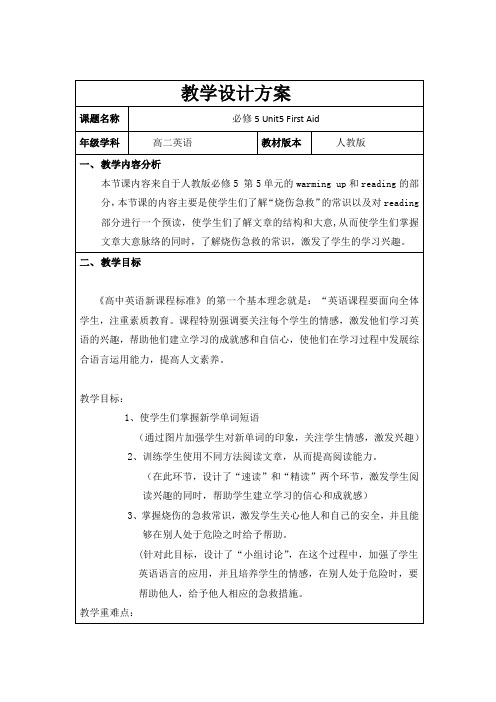
精美句子1、善思则能“从无字句处读书”。
读沙漠,读出了它坦荡豪放的胸怀;读太阳,读出了它普照万物的无私;读春雨,读出了它润物无声的柔情。
读大海,读出了它气势磅礴的豪情。
读石灰,读出了它粉身碎骨不变色的清白。
2、幸福幸福是“临行密密缝,意恐迟迟归”的牵挂;幸福是“春种一粒粟,秋收千颗子”的收获. 幸福是“采菊东篱下,悠然见南山”的闲适;幸福是“奇闻共欣赏,疑义相与析”的愉悦。
幸福是“随风潜入夜,润物细无声”的奉献;幸福是“夜来风雨声,花落知多少”的恬淡。
幸福是“零落成泥碾作尘,只有香如故”的圣洁。
幸福是“壮志饥餐胡虏肉,笑谈渴饮匈奴血”的豪壮。
幸福是“先天下之忧而忧,后天下之乐而乐”的胸怀。
幸福是“人生自古谁无死,留取丹心照汗青”的气节。
3、大自然的语言丰富多彩:从秋叶的飘零中,我们读出了季节的变换;从归雁的行列中,我读出了集体的力量;从冰雪的消融中,我们读出了春天的脚步;从穿石的滴水中,我们读出了坚持的可贵;从蜂蜜的浓香中,我们读出了勤劳的甜美。
4、成功与失败种子,如果害怕埋没,那它永远不能发芽。
鲜花,如果害怕凋谢,那它永远不能开放。
矿石,如果害怕焚烧(熔炉),那它永远不能成钢(炼成金子)。
蜡烛,如果害怕熄灭(燃烧),那它永远不能发光。
航船,如果害怕风浪,那它永远不能到达彼岸。
5、墙角的花,当你孤芳自赏时,天地便小了。
井底的蛙,当你自我欢唱时,视野便窄了。
笼中的鸟,当你安于供养时,自由便没了。
山中的石!当你背靠群峰时,意志就坚了。
水中的萍!当你随波逐流后,根基就没了。
空中的鸟!当你展翅蓝天中,宇宙就大了。
空中的雁!当你离开队伍时,危险就大了。
地下的煤!你燃烧自己后,贡献就大了6、朋友是什么?朋友是快乐日子里的一把吉它,尽情地为你弹奏生活的愉悦;朋友是忧伤日子里的一股春风,轻轻地为你拂去心中的愁云。
朋友是成功道路上的一位良师,热情的将你引向阳光的地带;朋友是失败苦闷中的一盏明灯,默默地为你驱赶心灵的阴霾。
人教新课标高中英语必修五Unit5FirstaidUnit5Firstaid教案.docx
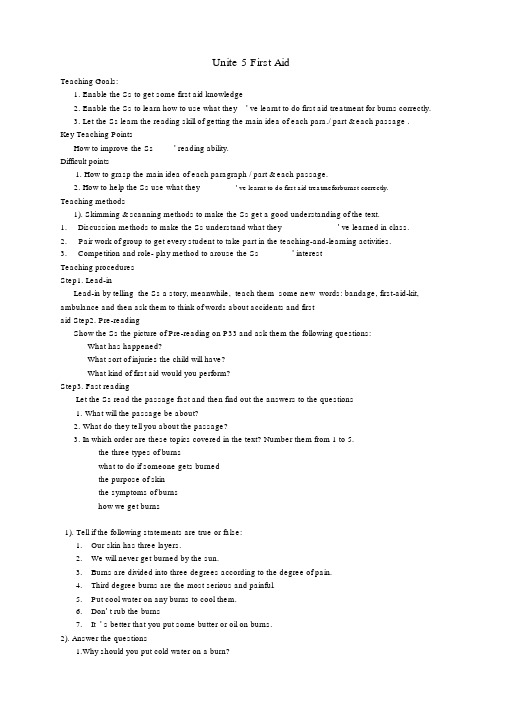
Unite 5First AidTeaching Goals:1.Enable the Ss to get some first aid knowledge2.Enable the Ss to learn how to use what they ’ ve learnt to do first aid treatment for burns correctly.3.Let the Ss learn the reading skill of getting the main idea of each para./ part & each passage .Key Teaching PointsHow to improve the Ss’ reading ability.Difficult points1. How to grasp the main idea of each paragraph / part & each passage.2. How to help the Ss use what they’ ve learnt to do first aid treatmeforburnst correctly.Teaching methods1). Skimming & scanning methods to make the Ss get a good understanding of the text.1. Discussion methods to make the Ss understand what they’ ve learned in class.2.Pair work of group to get every student to take part in the teaching-and-learning activities.3. Competition and role- play method to arouse the Ss’ interestTeaching proceduresStep1. Lead-inLead-in by telling the Ss a story, meanwhile, teach them some new words: bandage, first-aid-kit, ambulance and then ask them to think of words about accidents and firstaid Step2. Pre-readingShow the Ss the picture of Pre-reading on P33 and ask them the following questions: What has happened?What sort of injuries the child will have?What kind of first aid would you perform?Step3. Fast readingLet the Ss read the passage fast and then find out the answers to the questions1.What will the passage be about?2.What do they tell you about the passage?3.In which order are these topics covered in the text? Number them from 1 to 5.____ the three types of burns____ what to do if someone gets burned____ the purpose of skin____ the symptoms of burns____ how we get burns1). Tell if the following statements are true or false:1.Our skin has three layers.2.We will never get burned by the sun.3.Burns are divided into three degrees according to the degree of pain.4.Third degree burns are the most serious and painful.5.Put cool water on any burns to cool them.6.Don’ t rub the burns7.It ’ s better that you put some butter or oil on burns.2). Answer the questions1.Why should you put cold water on a burn?2.Why doesn’ t a third degree burn hurt?3.Why do you think clothes and jewellery near burns should be removed?4.If someone has a third degree burn, why might you see tissue?3). Read the text again and then find out how many parts there are and the main idea of each part:Part1. The purpose / function of skinPart2. Causes of burns hot liquids, steam, fire, radiation, the sun, electricity, chemicalsPart3. Types of burns: First degree burns, Second degree burns, Third degree burnsPart4. Characteristics of burnsPart5 First aid treatment3). Finish off Comprehending Ex2&3Step5. Words competitionHave a competition to check the Ss ’ words spelling Step6.Making a first-aid kitAn activity to let the Ss know what are included in a first-aid-kitA well-stocked( 存得好的 ) first-aid kit, kept in easy reach, is necessary in every home. It should include: bandage, alcohol, flashlight, thermometer, soap, sharp scissors, plastic gloves (at least 2 pairs), your list of emergency phone numbers etc.Step7. Role playWork in pairs to act out how to place an emergency call for helpStep8. SummaryThis passage doesn ’ t contain enough information for you to do first aid f o thers. Please learn more after class. Do remember: Life is precious, we should care about others and help people in an emergency and try our best to give them effective first aid if they are in danger. Period 2. Language points.1.aid帮助,援助,助first aid急救come/ go to sb ’said援助某人with the aid of在⋯ 的帮助下aid sb with sth帮助某人做某事aid sb in doing sth帮助某人做某事②He was able to find the museum with the aid of a map.③We aided him in raising the money.2. fall ill生病属短性,不与for +be ill指生病的状,是持性行, 可与His wife suddenly fell ill last week.He has been ill for a week.fall用作系 ,后常接形容.fall asleep睡着fall silent沉默不3. save one ’ s life救某人的命save one ’ s honor保全名誉save one ’ s face保全面子save one ’ s skin避免受4 Did you or someone else give help in any of them? If so, If so, = If it is true,段用for + 段用⋯Do you want to be a superman? If so, come with me!If so, = If it is so5 bite (bit, bitten)bite off more than one can chew多嚼不Once bitten, twice shy.吃一,一智。
人教新课标高中英语必修五Unit+5+First+Aid+教案1.doc
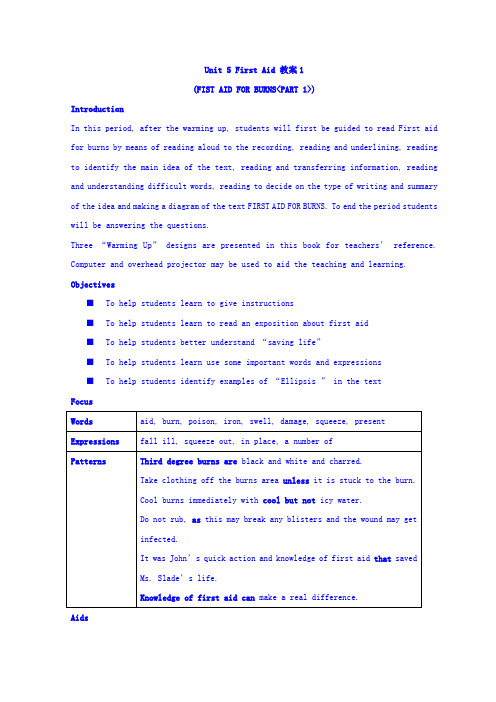
Unit 5 First Aid 教案1(FIST AID FOR BURNS<PART 1>)IntroductionIn this period, after the warming up, students will first be guided to read First aid for burns by means of reading aloud to the recording, reading and underlining, reading to identify the main idea of the text, reading and transferring information, reading and understanding difficult words, reading to decide on the type of writing and summary of the idea and making a diagram of the text FIRST AID FOR BURNS. To end the period students will be answering the questions.Three “Warming Up” designs are presented in this book for teachers’ reference. Computer and overhead projector may be used to aid the teaching and learning. Objectives■To help students learn to give instructions■To help students learn to read an exposition about first aid■To help students better understand “saving life”■To help students learn use some important words and expressions■To help students identify examples of “Ellipsis ” in the textFocusAidsMultimedia facilities, tape-recorder, photos, diagrams1. Warming up⑴ Warming up by describingGood morning, class. Today we are going to read about FIRST AID FOR BURNS. Then what’s first aid is and why is it important?Now turn to page 33, look at the pictures. What has happened in each picture?⑵ Warming up by discussingHi, every one. Have you been in any of the emergency situations? Did you or someone else give help then? If so, what kind of help? When you are involved in the emergency situations, what kind of first aid should you need or give? Think it over, and then give us your answers.⑶ Warming up by talking about first aid situationsMedical emergencies don't occur every day. But when they do, information can help you deal with these situations. Then in what situations do we need to offer or receive first aid?2. Pre-reading by looking and sayingWork in pairs. Look at the picture on page 33, at the bottom of right corner, and tell us what has happened in the picture. What sort of injuries will the child have? What first aid treatment would you give in this situation?3. Reading⑴ Reading aloud to the recordingNow please listen and read aloud to the recording of the text FIRST AID FOR BURNS. Pay attention to the pronunciation of each word and the pauses within each sentence. I will play the tape twice and you shall read aloud twice, too.⑵ Reading and underliningNext you are to read and underline all the useful expressions or collocations in the passage. Copy them into your notebook and write a short passage, making use of them after class as homework.⑶ Reading to identify the main idea of the textRead the title of the text and the headings within it. Tell us what the main idea of the text is and how the information is organized.⑷ Reading and transferring informationRead the text again to answer the questions.a. How is the information organized within the headings of Types of burns and Characteristics of burns?b. Why is the information numbered under the heading of Fist aid treatment?⑸ Reading and understanding difficult wordsRead the text with a partner and underline any words you are not sure about. Try your best to guess the meaning of these words. If no one can give the correct meaning, you can look up the dictionary.⑹ Reading to decide on the type of writing and summary of the idea4.HomeworkDo exercise on page36.品味人生1、不管鸟的翅膀多么完美,如果不凭借空气,鸟就永远飞不到高空。
人教版高中英语必修5《Unit5firstaid》教案
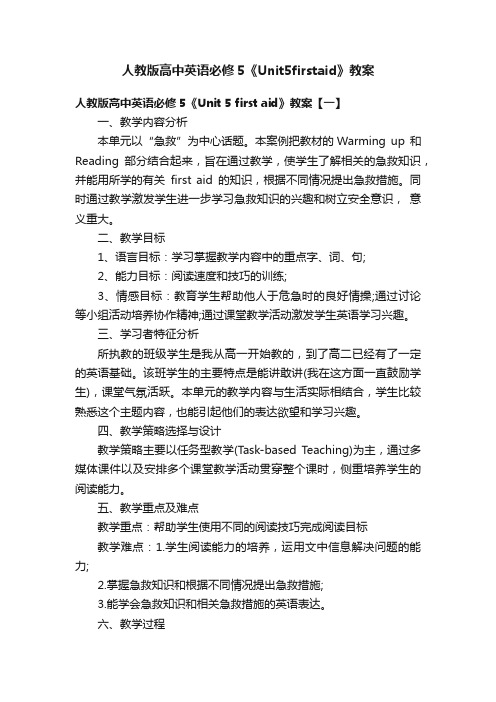
人教版高中英语必修5《Unit5firstaid》教案人教版高中英语必修5《Unit 5 first aid》教案【一】一、教学内容分析本单元以“急救”为中心话题。
本案例把教材的Warming up 和Reading部分结合起来,旨在通过教学,使学生了解相关的急救知识,并能用所学的有关first aid的知识,根据不同情况提出急救措施。
同时通过教学激发学生进一步学习急救知识的兴趣和树立安全意识,意义重大。
二、教学目标1、语言目标:学习掌握教学内容中的重点字、词、句;2、能力目标:阅读速度和技巧的训练;3、情感目标:教育学生帮助他人于危急时的良好情操;通过讨论等小组活动培养协作精神;通过课堂教学活动激发学生英语学习兴趣。
三、学习者特征分析所执教的班级学生是我从高一开始教的,到了高二已经有了一定的英语基础。
该班学生的主要特点是能讲敢讲(我在这方面一直鼓励学生),课堂气氛活跃。
本单元的教学内容与生活实际相结合,学生比较熟悉这个主题内容,也能引起他们的表达欲望和学习兴趣。
四、教学策略选择与设计教学策略主要以任务型教学(Task-based Teaching)为主,通过多媒体课件以及安排多个课堂教学活动贯穿整个课时,侧重培养学生的阅读能力。
五、教学重点及难点教学重点:帮助学生使用不同的阅读技巧完成阅读目标教学难点:1.学生阅读能力的培养,运用文中信息解决问题的能力;2.掌握急救知识和根据不同情况提出急救措施;3.能学会急救知识和相关急救措施的英语表达。
六、教学过程教师活动学生活动设计意图Step 1. Leading-in1. Greetings2. What words can you think of when talking about home accidents and first aid?3. First aid quiz (according to the pictures shown on Page 33)4. Definition of first aid: a temporary form of help given to someone who suddenly falls ill or gets injured before a doctor can be found.GreetingsBrainstorming(cut, nosebleed, choking, burn...)Watch, read and think, then work in groups to make the choicesRead aloud and understand the definition通过问题自然引入本课内容日常急救知识小测试,使学生自然顺利进入新课学习让学生朗读理解定义Step 2. Pre-readingPresent the picture on Page 33 and ask the students to answer the questions of Pre-reading.Ask the students to look at the title and subtitle, and predict: What may be written in the text? Look at the picture carefully and discuss in groups. Choose one student to give the answers. (Answers can vary)Students look at the title and subtitle and give their prediction. 利用课文图片导入主题:FIRST AID FOR BURNS 培养学生通过标题和小标题预测阅读内容的能力,也激发学生进一步阅读以验证预测Step 3. While-readingReading for general idea1. Make the students to skim the passage in limited time and get a general idea, then ask the students to divide the passage into 5 parts.2. In which order are these topics covered in the text?(Page 35)Reading for details (Get the students to read the text part by part)1. Ask the question:What is skin? What can get the skin burned? What is the function of the skin?2. Types of burns and their characteristics. Do Ex.2 of Page 35.(Label the pictures)3. Answer the following questions. (Ex.3, Page 35)Students skim the passage to find the answer.Students work individually to give the right answers.Students read and find out the answers. Do related exercises.限时阅读培养学生快速阅读的能力和通过略读理解大意独立完成,培养学生独立学生的能力,同时也是为了充分了解学生的课文理解情况培养学生把握文章细节的能力; 培养学生通过阅读寻找所需信息的能力; 培养学生根据信息进行判断的能力Step 4. Post-reading1. Give a few minutes for the students to read after the tape.2. Ask the students to judge the treatments of Ex.4.3. Ask the students to practise to give first aid treatments to different burns and then act it out.Students read aloud after the tape.Students read and make their judgement.Students practise in groups and act. 语音语调锻炼,同时也使得学生进一步理解所学课文本环节为输出阶段,目的在于检查学生的学以致用创设活动任务,培养学生解决实际问题的能力Step 5. Homework1. Get more about first aid from the newspaper, magazine or the Internet.2. Find out the important and difficult words and expressions to you and finish exercises on page 36.Students get ready for homework. 所布置的作业把学生的学习任务从课堂延伸到课外,有利于巩固课堂所学和进一步让学生掌握更多的急救知识七、教学评价设计评价采用了自我评价、小组比赛、学生互评和教师评价相结合的方式。
高中英语 Unit5 First aid教案 新人教版必修5-新人教版高二必修5英语教案
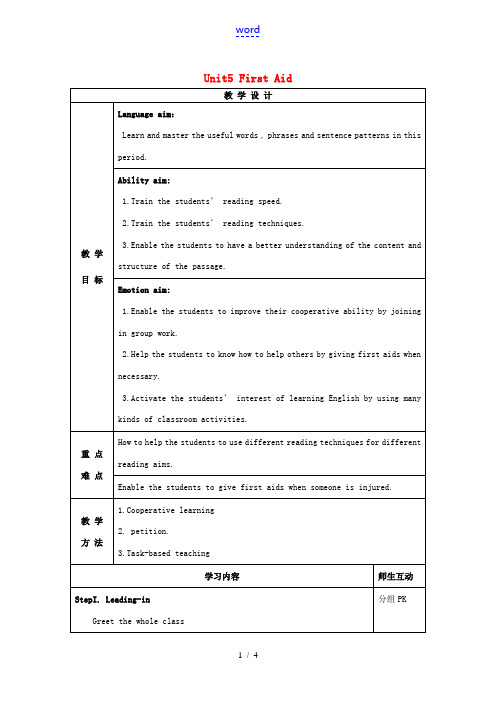
Unit5 First AidStepⅡ. Present 6 pictures and ask1.What has happened?2.How to deal with it?StepⅢ.Talk about the picture and answer the questions.1.What has happened to the little girl?2.What can we do to help her?StepⅣ. Fast readingRead the text quickly and finish the task: In which order are these topics organized in the text? Number them from 1 to 5.____ the three types of burns____ what to do if someone gets burned____ the purpose of skin____ the symptoms of burns____ how we get burnsStepⅤ. Detailed readingRead Part 1 and write down the purpose of skin:1〕Protect you against , and;2〕Keep you or ;3) Prevent you from ;4) Give you .Read Part 2 and find out the causes of burns.You can get burnt by : ________________________________________ 认真观察,各小组积极发言StepⅣ快速限时默读4’,理解文章分段及大意StepⅤ1.听录音,填写。
2.仔细阅读,从课文中找出关键词,培养学生查找kettle, steam pour out ofRead Part 3 and find out some information about types of burns.There are _______ types of burns depending on which _______ are burned._______________ affect only the _____ layer and should feel better within _______________.________________ affect both the _____ and the_______ layer. These burns are _______ and take ______________ to heal.________________ affect all ______ layers and any ______ and ______ under the skin. They are very _______ injuries and the victim must go to a ________at once.Read part 4 carefully, match the types of burns with the pictures and answer some questions.Types of burns CharacteristicsExtremely painfulRead part 5 carefully. Do you know why:1.Why should you put cold water on a burn?_______________________________________________________2.Why doesn’t a third degree burn hurt?_______________________________________________________StepⅤ.DiscussionStepⅥ.Summary 细节的能力。
人教版高中英语必修5教案Unit 5 First Aid

人教版高中英语必修5教案 Unit 5: First Aid一、教学目标1.掌握本单元的重点单词和短语,并能正确运用于实际生活中;2.能够通过阅读和听力理解有关急救和事故处理的文章,并能够从中获取关键信息;3.培养学生的合作意识和团队精神,通过小组讨论和合作实践,提高学生的自主学习和解决问题的能力;4.培养学生的英语口语表达能力和写作能力,通过角色扮演和写作练习,提高学生的语言运用能力和思维能力;5.通过跨学科的学习,培养学生的综合素质、创新思维和实践能力。
二、教学内容本单元主要内容包括以下几个方面:1.单词与短语:emergency, victim, conscious, unconscious, ambulance, injury, bandage, sprain, bleed, wound, choke, etc.2.语法:被动语态的使用;3.阅读理解:阅读有关急救和事故处理的文章,提高学生的阅读理解和信息获取能力;4.听力训练:通过听取录音材料,提高学生的听力理解能力和听写能力;5.口语表达:通过角色扮演和小组讨论,提高学生的口语表达能力和思维能力;6.写作训练:通过写作练习,培养学生的写作能力和文化意识。
三、教学过程第一课时1.温故知新:通过复习上一单元的重点单词和短语,引入本单元的话题,并激发学生的学习兴趣。
2.导入新课:介绍本单元的学习目标并让学生做预测,激发学生的学习兴趣和学习动力。
3.新课讲解:通过教师讲解和多媒体展示,讲解本单元的重点单词和短语,并进行例句的讲解和练习。
4.学习活动:分组进行单词和短语的拼写和运用训练,培养学生的团队合作和解决问题的能力。
5.拓展延伸:通过课堂讨论和小组展示,让学生拓展和延伸本单元的话题,培养学生的思维能力和创新能力。
第二课时1.温故知新:通过复习上一课的重点单词和短语,引导学生回忆上节课的内容,并复习被动语态的用法。
2.导入新课:通过展示一段有关急救的视频,激发学生的学习兴趣和对急救知识的关注。
高中英语人教版必修五Unit 5 First Aid-FirstAid for Burns教案

教学设计《普通高中课程标准实验教科书英语》必修5 Unit5 First Aid-First Aid for Burns所教年级高二年级单元Unit5 First Aid-First Aid for Burns本节课以First Aid for Burns为话题,结合学生日常生活中经常发生的小意外以及处理方法,设计了warming up部分;Reading部分主要围绕First Aid for Burns主要设计主题了解如何处理不同程度的烧伤。
1.整体设计思路本单元出自是人民教育出版社出版的高二英语新教材必修5的第五单元First Aid-First Aid fo rBurns,其中心话题围绕“First Aid”展开,reading部分是本课的重点,重在训练学生精确找到阅读信息的能力,并且从阅读中获取解决实际问题的技能,如怎样判断烧伤的不同等级以及如何处理烧伤。
本课所学到的知识有利于学生解决生活中的实际问题。
Warming-up 以学生实际生活中可能遇到的小意外的照片引入话题,激发学生兴趣;阅读部分以阅读任务推动,引导学生发展阅读能力;读后部分以小组为单位学习不同小意外的处理方法,然后进行班级分享,鼓励学生以动作、语言输出所学知识,并结合实际情况学以致用。
总结部分采用新闻视频,让学生观看一名护士利用急救知识偶然在高速公路上久了一名发生车祸的陌生人的新闻报道,引导学生形成用所学拯救他人的价值观,弘扬社会主义核心价值观。
2.教学背景分析本课的授课对象是高二的学生,已经积累了一定的英语阅读技巧,但学生不习惯用英语表达。
学生情况分析:本单元所涉及的话题对于学生来说并不陌生,但是学生平时很少关注具体情况下的急救办法,希望教材分析:通过本课的学习,教会学生如何应对可能出现的生活小意外,并提高急救意识。
3.教学目标分析1.Get familiar with some useful words , phrases and sentence patterns in this passage. Teaching aims:2. Improve the reading skills3.Know some simple skills of first aid and use what we have learned to help othersaching important and difficult points:Get students to acquire some first aid skills through readingHow to output what they learnt into practice to solve some daily problems.5.教学过程设计Teaching procedures:tep2.Lead-in(Teacher should take some photos about daily accidents of students before lass.) Look at the pictures. What happened to the students? What should we do to helphem? (Draw students' attention to the topic "First Aid")2. Task1:What is first aid?A form of help given to someone who suddenly fall ill.There are other times when giving first aid quickly can save people's lives.Step3. Reading1.Fast reading:Task2:Scan for the structure of the passagePart 1:The Introduction of the skinpart 2: the characteristics of burnsPart 3: the treatment of burns2.Detailed reading:1.:What may cause burns?2: What is the feature of second degree burns?3: Why is it necessary to remove the burns?Step 4: Summarize and homework。
人教新课标高中英语必修五Unit 5 First aidUnit 5 First aid教案
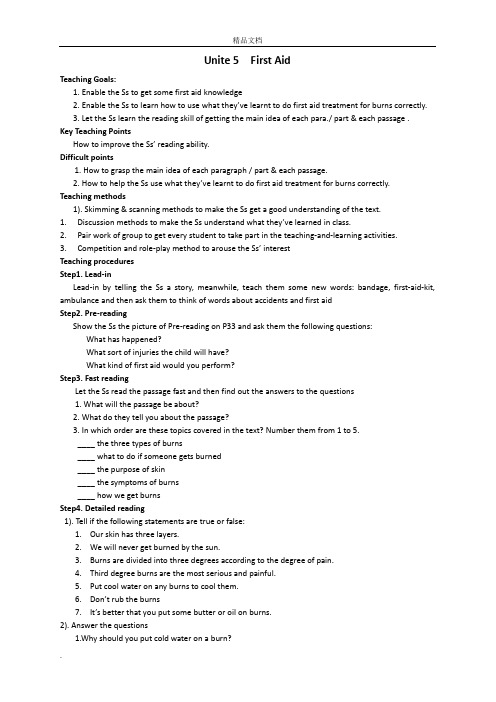
Unite 5 First AidTeaching Goals:1. Enable the Ss to get some first aid knowledge2. Enable the Ss to learn how to use what they’ve learnt to do first aid treatment for burns correctly.3. Let the Ss learn the reading skill of getting the main idea of each para./ part & each passage .Key Teaching PointsHow to improve the Ss’ reading ability.Difficult points1. How to grasp the main idea of each paragraph / part & each passage.2. How to help the Ss use what they’ve learnt to do first aid treatment for burns correctly. Teaching methods1). Skimming & scanning methods to make the Ss get a good understanding of the text.1.Discussion methods to make the Ss understand what they’ve learned in class.2.Pair work of group to get every student to take part in the teaching-and-learning activities.petition and role-play method to arouse the Ss’ interestTeaching proceduresStep1. Lead-inLead-in by telling the Ss a story, meanwhile, teach them some new words: bandage, first-aid-kit, ambulance and then ask them to think of words about accidents and first aidStep2. Pre-readingShow the Ss the picture of Pre-reading on P33 and ask them the following questions: What has happened?What sort of injuries the child will have?What kind of first aid would you perform?Step3. Fast readingLet the Ss read the passage fast and then find out the answers to the questions1. What will the passage be about?2. What do they tell you about the passage?3. In which order are these topics covered in the text? Number them from 1 to 5.____ the three types of burns____ what to do if someone gets burned____ the purpose of skin____ the symptoms of burns____ how we get burnsStep4. Detailed reading1). Tell if the following statements are true or false:1.Our skin has three layers.2.We will never get burned by the sun.3.Burns are divided into three degrees according to the degree of pain.4.Third degree burns are the most serious and painful.5.Put cool water on any burns to cool them.6.Don’t rub the burns7.It’s better that you put so me butter or oil on burns.2). Answer the questions1.Why should you put cold water on a burn?2.Why doesn’t a third degree burn hurt?3.Why do you think clothes and jewellery near burns should be removed?4.If someone has a third degree burn, why might you see tissue?3). Read the text again and then find out how many parts there are and the main idea of each part: Part1.The purpose / function of skinPart2. Causes of burns hot liquids, steam, fire, radiation, the sun, electricity, chemicalsPart3. Types of burns: First degree burns, Second degree burns, Third degree burnsPart4. Characteristics of burnsPart5 First aid treatment3). Finish off Comprehending Ex2&3Step5. Words competitionHave a competition to check the Ss’ words spellingStep6. Making a first-aid kitAn activity to let the Ss know what are included in a first-aid-kitA well-stocked(存备得好的) first-aid kit, kept in easy reach, is necessary in every home. It should include:bandage, alcohol, flashlight, thermometer, soap, sharp scissors, plastic gloves (at least 2 pairs), your list of emergency phone numbers etc.Step7. Role playWork in pairs to act out how to place an emergency call for helpStep8. SummaryThis passage doesn’t contain enough information for you to do first aid for others. Please learn more after class. Do remember: Life is precious, we should care about others and help people in an emergency and try our best to give them effective first aid if they are in danger.Period 2. Language points.1.aid 帮助,援助,赞助first aid 急救come/ go to sb’s aid 援助某人with the aid of 在…的帮助下aid sb with sth 帮助某人做某事aid sb in doing sth 帮助某人做某事Eg. ①He came to my aid at once.②He was able to find the museum with the aid of a map.③We aided him in raising the money.2. fall ill 生病属短暂性动词, 不与for + 时间段连用be ill 指生病的状态,是持续性行为, 可与for + 时间段连用His wife suddenly fell ill last week.He has been ill for a week.fall 用作系动词,后常接形容词.fall asleep 睡着fall silent 沉默不语3. save one’s life 救某人的命save one’s honor保全名誉save one’s face保全面子save one’s skin 避免受伤4 Did you or someone else give help in any of them? If so, …If so, = If it is true,Do you want to be a superman? If so, come with me!If so, = If it is so5 bite (bit, bitten)bite off more than one can chew贪多嚼不烂Once bitten, twice shy. 吃一堑,长一智。
【配套K12】高中英语 Unit 5 First aid Grammar教案 新人教版必修5
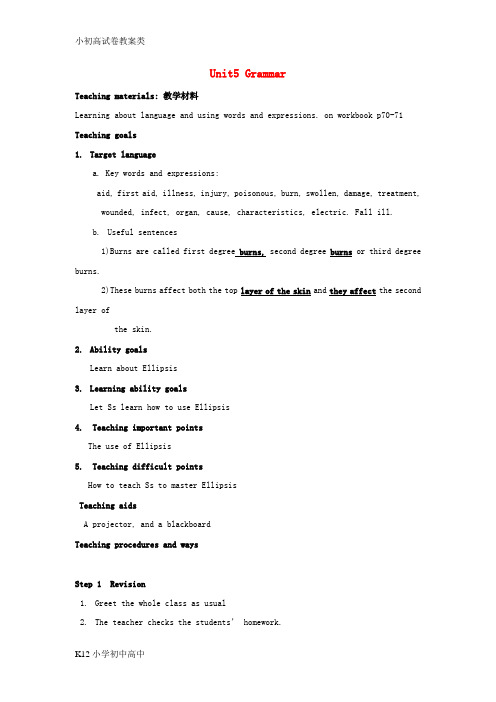
Unit5 GrammarTeaching materials: 教学材料Learning about language and using words and expressions. on workbook p70-71 Teaching goals1.Target languagea. Key words and expressions:aid, first aid, illness, injury, poisonous, burn, swollen, damage, treatment, wounded, infect, organ, cause, characteristics, electric. Fall ill.eful sentences1)Burns are called first degree burns, second degree burns or third degree burns.2)These burns affect both the top layer of the skin and they affect the second layer ofthe skin.2.Ability goalsLearn about Ellipsis3.Learning ability goalsLet Ss learn how to use Ellipsis4. Teaching important pointsThe use of Ellipsis5. Teaching difficult pointsHow to teach Ss to master EllipsisTeaching aidsA projector, and a blackboardTeaching procedures and waysStep 1 Revision1.Greet the whole class as usual2.The teacher checks the students’ homework.Step 2 Word StudyT: Now please open your books and turn to Page 36. Let’s learn “Learning about Language”.First let’s d o Discovering useful words and expressionsplete the table with the correct verbs, nouns or adjectives.T: Let’s do some more exercises about new words. You are to explain the words on the screenin English and then fill in the blanks.(ask students to explain or guess the meanings of the words)plete the questions with words from the text.The students will try to complete the exercises. Later the teacher will ask some of them to read each of the sentences and tell the class the answers.Suggested answers:Step 3: GrammarT: Let’s look at the next, Grammar (page 91)Present some sentences and encourage the students to find out which words have been left out.T: Observe the following sentences and discuss with your partner to find out what have been left out. Let me show you an example. As we know, when people want the speaker to repeat what he said, they usually say “ Beg your pardon.”Then it is called Ellipsis. The subject “I” has been left out, without changing the meaning of th e sentence .OK, now it’s your turn to find out what have been left out.1.Haven’t seen you for ages.2.Some more tea?3.Sounds like a good idea.4.Doesn’t matter.5.Sorry to hear that.6.Pity you couldn’t come7.This way, please.8.Terrible weather!9.Joining us for a drink?10.Going to the supermarket?Suggested answers:1.I haven’t seen you for ages.2.Would you like some more tea?3.That/It sounds like a good idea.4.It doesn’t matter.5.I’m sorry to hear that.6.It’s/ What pity you couldn’t come7.Step this way, please.8.What terrible weather it is!9.Are you joining us for a drink?10.Are you going to the supermarket?Step 5 Homework1. Go over the usage of Ellipsis.2. Finish listing structures on Page 71 Ex 1 and Ex 23. Prepare Reading and discussing on Page 38。
- 1、下载文档前请自行甄别文档内容的完整性,平台不提供额外的编辑、内容补充、找答案等附加服务。
- 2、"仅部分预览"的文档,不可在线预览部分如存在完整性等问题,可反馈申请退款(可完整预览的文档不适用该条件!)。
- 3、如文档侵犯您的权益,请联系客服反馈,我们会尽快为您处理(人工客服工作时间:9:00-18:30)。
高中英语人教新课标必修五Unit 5 First aidGrammarTeaching goalsTeaching materials: 教学材料Learning about language and using words and expressions. on workbook p70-711.Target languagea. Key words and expressions:aid, first aid, illness, injury, poisonous, burn, swollen, damage, treatment, wounded, infect, organ, cause, characteristics, electric. Fall ill.eful sentences1)Burns are called first degree burns, second degree burns or third degree burns.2)These burns affect both the top layer of the skin and they affect the second layer ofthe skin.2.Ability goalsLearn about Ellipsis3.Learning ability goalsLet Ss learn how to use Ellipsis4. Teaching important pointsThe use of Ellipsis5. Teaching difficult pointsHow to teach Ss to master EllipsisTeaching aidsA projector, and a blackboardTeaching procedures and waysStep 1 Revision1.Greet the whole class as usual2.The teacher checks the students’ homework.Step 2 Word StudyT: Now please open your books and turn to Page 36. Let’s learn “Learning about Language”.First let’s do Discovering useful words and expressionsplete the table with the correct verbs, nouns or adjectives.T: Let’s do some more exercises about new words. You are to explain the words on the screen in English and then fill in the blanks.(ask students to explain or guess the meanings of the words)plete the questions with words from the text.The students will try to complete the exercises. Later the teacher will ask some of them to read each of the sentences and tell the class the answers.Suggested answers:Step 3: GrammarT: Let’s look at the next, Grammar (page 91)Present some sentences and encourage the students to find out which words have been left out. T: Observe the following sentences and discuss with your partner to find out what have been left out. Let me show you an example. As we know, when people want the speaker to repeat what he said, they usually say “ Beg your pardon.” Then it is called Ellipsis. The subject “I” has been left out, without changing the meaning of the sentence .OK, now it’s your turn to find out what have been left out.1.Haven’t seen you for ages.2.Some more tea?3.Sounds like a good idea.4.Doesn’t matter.5.Sorry to hear that.6.Pity you couldn’t come7.This way, please.8.Terrible weather!9.Joining us for a drink?10.Going to the supermarket?Suggested answers:1.I haven’t seen you for ages.2.Would you like some more tea?3.That/It sounds like a good idea.4.It doesn’t matter.5.I’m sorry to hear that.6.It’s/ What pity you couldn’t come7.Step this way, please.8.What terrible weather it is!9.Are you joining us for a drink?10.Are you going to the supermarket?Step 4 PractisingDiscovering useful structures (page 37)1.In groups, look at these pairs of sentences. Discuss the difference between A and B ineach pair. Also discuss which is the better sentence, A or B and Why.(page 37)2.Rewrite these sentences taking out the unnecessary parts.1)The burn that she got from the iron was red and ( it was )very painful2) A boy was on the left side of the sick woman, and a girl was on the right (side ofthe sick woman.)3)She has a daughter (who is) in hospital.4)He went to the doctor because he had to go to( the doctor).5)Did she pass the first aid test that she did yesterday (or didn’t she pass)?6)She could not decide whether to send him to hospital or not (to send him tohospital).7)When your nose is bleeding, you should bend forward so that the blood runs out ofyour nose and( the blood) doesn’t run down your throat.8)Only some of the students have done a first aid course but most of the studentshaven’t (done a first aid course).3.These sentences are correct. However, one or more words have been left out. Rewriteeach sentence on the top of the next page to include the missing words.1)The cottage (that is) surrounded by a wall belongs to the local government.2)The first book I read this term was more interesting than the second (book I readthis term).3)To her teacher’s surprise, she did better in her first aid exam than(it was) expected.4)I don’t think they have returned from the hospital, but they might have ( returnedfrom the hospital).5)He wanted to help the accident victim but his friend didn’t (want to help theaccident victim).6)You can borrow my first aid notes if you want to (borrow my first aid notes).4.Show the students the slides with some multiple choices exercises about the Ellipsis.1)---- Tomorrow is a holiday. Why are you doing your homework?-----I am doing these exercises now so that I won’t have _____ on Sunday.A. itB. themC. forD. to2)----Shall I invite Ann to my birthday party tomorrow evening?----Yes. It’ll be fine if you______.A. areB. canC. inviteD. do3)---- Aren’t you the manager?-----No, and I______A.don’t want toB. don’t want to beC. don’t want beD. don’t want4)---- I’ll be away on a business trip. Would you mind looking after my cat?-----Not at all______.A. not toB. not to doC. not do itD. do not to5)----- Won’t you have another try?------ ________.A.Yes, I will haveB. Yes, I won’t haveC. Yes, I won’tD. Yes, I will6)-----I won’t do it any more.-----_______?A. Why notB. Why don’t do any moreC. Why not doD. Why don’t7)-----Do you think it will snow tomorrow?------______?A.I don’t thinkB. No, I don’t thinkC. I don’t think soD. No, I don’t so8)-----Have you fed the cat?------No, but______.A. I’mB. I amC. I’m just goingD. I’m just going toStep 5 Homework1. Go over the usage of Ellipsis.2. Finish listing structures on Page 71 Ex 1 and Ex 23. Prepare Reading and discussing on Page 38。
